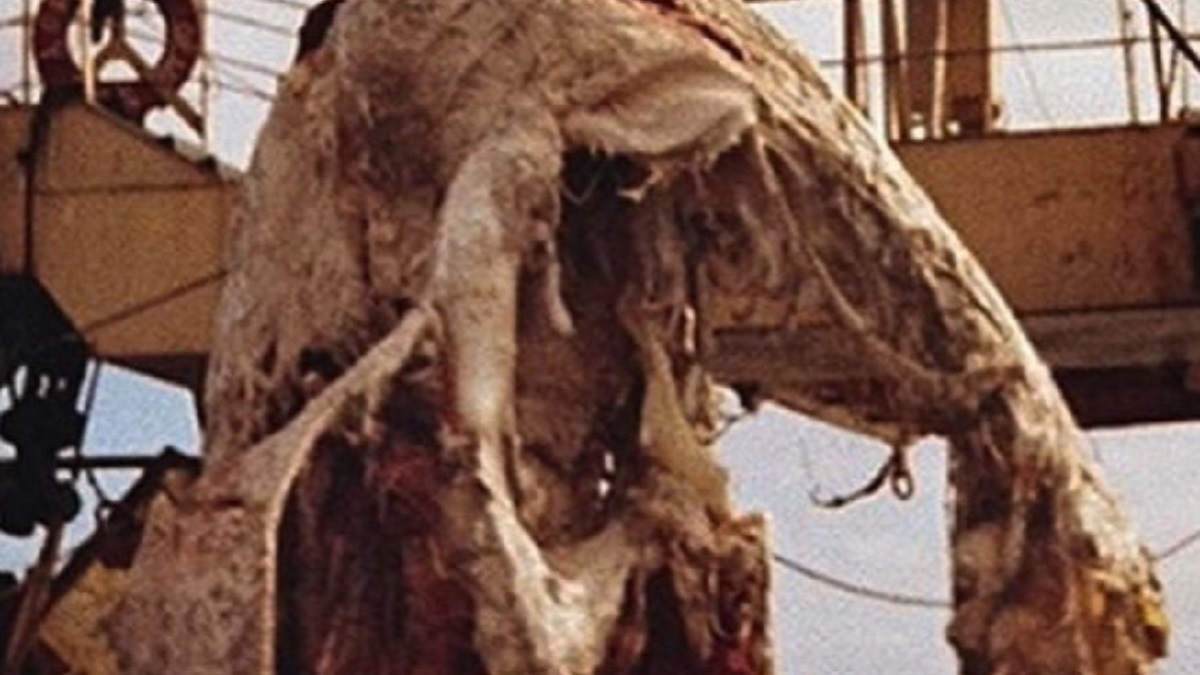
Alleged photograph of the Nessie-like monster the crew of the Zuiyo-maru discovered off the coast of New Zealand. Pic credit: via All Things Creepy/YouTube
Fishermen allegedly found New Zealand’s version of the Scottish Loch Ness monster off the coast of the island country in 1977.
A Japanese fishing trawler reportedly pulled the half-decomposed carcass of a strange dinosaur-like sea creature from the bottom of the ocean while fishing in waters off the coast of New Zealand in the southwestern Pacific Ocean.
However, the carcass was so rotten and stinky that the fishermen threw it back into the water.
But they snapped pictures and took samples before tipping it overboard.
Fishermen puzzled by the strange find
The crew of Zuiyo Maru, a Japanese trawler, pulled up the dinosaur-like sea monster in April 1977 while trawling in waters off the coast of Christchurch.
The fishermen were puzzled by the strange find.
Crew members were veteran fishermen familiar with the species native to the southwestern Pacific Ocean. But none had ever seen a creature similar in appearance and size to the strange carcass.
Akira Tanaka, captain of the ship, was convinced they had accidentally discovered a new species of marine creature.
Believing that discovery could be significant, he wanted to keep the carcass so that marine biologists could examine and analyze it. However, his crew did not want to keep it due to the unbearable stench of the rotten carcass and concern that it might contaminate their fish haul.
So they snapped photographs and took skeletal, flesh, skin, and fin samples before throwing the carcass back into the water.
Description of the New Zealand Nessie
Surviving photographs seemed to show the carcass of a 30-foot sea monster weighing nearly 2,000kg.
Eyewitnesses described it as a dinosaur-like sea creature with an extended flexible neck, paddle- or fin-like limbs, and a tail about 2 meters long.
The carcass was in an advanced stage of decomposition, and much of the internal organs were missing, likely eaten by underwater scavengers.
However, there was enough intact flesh and body fat. The seamen took samples of the flesh, fat, and bones. They preserved and delivered them to marine biologists at Tokyo and Yokohama universities.
Some experts suggested it was an ancient plesiosaur
Based on the description of the carcass, examination of the photographs, and analysis of the samples, some biologists reportedly concluded it was likely a marine dinosaur known as a plesiosaur.
Plesiosaurs were ancient marine reptiles that first appeared in the Rhaetian age of the Triassic Period about 205-203 million years ago.
They flourished during the Jurassic era, populating oceans worldwide. Some species even adapted to life in inland freshwater environments.
Experts believe that plesiosaurs disappeared during the mass extinction event at the end of the Cretaceous Period about 66 million years ago.
Cryptozoology and plesiosaurs
Evidence that plesiosaurs lived in coastal waters and extended their habitat to inland freshwaters explains suggestions that coastal and inland lake monsters, such as the Scottish Loch Ness monster could be surviving plesiosaurs.
Other cryptids that cryptozoologists suspected might be surviving populations of ancient plesiosaurs include Morag, allegedly native to Loch Morar in the highlands of Scotland.
Some cryptozoologists also suggested that Morgawr, an alleged sea monster in Cornish folklore native to waters around Falmouth Bay off the south coast of Cornwall, could be a plesiosaur.
Other plesiosaur candidates include Cadborosaurus and Bear Lake Monster.
Skepticism
Although some believed that the carcass was the remains of a plesiosaur, others insisted that it was unlikely that plesiosaurs survived until modern times.
Plesiosaurs couldn’t live permanently underwater because they didn’t have lungs. Thus, they had to come to the surface frequently to breathe.
Skeptics argued that it was unlikely that a sea monster that had to surface frequently would remain undiscovered for long.
Other sources reported that analysis of amino acids in the creature’s flesh suggested it was likely a basking shark.